What is pass and cut in basketball
Pass and cut is a basketball offensive tactic that occurs when a player in possession of the ball, typically near the perimeter, passes it to another teammate, and afterwards, the passing player executes a cut, generally towards the basket in an effort to limit the effectiveness of the defense.
Why is pass and cut action potentially beneficial to the offensive team
Pass and cut action is potentially beneficial to the offensive team because it comprises ball movement as well as player motion which could lead to possible defensive breakdowns and subsequent scoring opportunities.
In other words, when a player passes the ball from one area of the court to another, this influences the other defenders that were not initially guarding the ball to move, primarily towards the ball.
Also, within man to man coverage, when a player is in motion, particularly after passing the ball, their own defender would be compelled to pursue after them to prevent that same moving player from getting open to receive the ball again.
So, if an offensive team is able to consistently execute pass and cut actions, this could then lead to defensive breakdowns in the form of various mistakes and/or possible scoring opportunities.
For example, when a player passes the ball, particularly against a man to man defense, that same player could then cut towards the basket, receive the ball again (i.e. give and go action), and then score at the rim.
This is especially effective if their defender is not attentive or their defender makes some other type of error such as simply having a bad defensive stance.
As another example, when an offensive player receives the ball after the pass, that same player’s defender might execute a poor defensive closeout which could lead to the offensive player performing a shot fake followed by dribble penetration to the basket.
Also, the defender may closeout too late or not closeout at all which could then lead to a lightly contested or completely uncontested jump shot for the offensive player that received the ball.
What are examples of basic pass and cut actions
Below are very simple examples of pass and cut actions between two players near the top, right side wing, right side corner, or right side low post area.
It should also be noted that the player numbers, 1 and 2, within these basic examples are not necessarily representative of standard basketball positions. Instead, the numbers are used mainly to provide easy to understand information.
Therefore, player 1 does not have to be a point guard and player 2 does not have to be a shooting guard.
Example 1
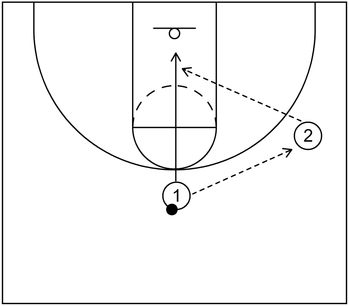
This is an example of basic pass and cut action when one player with the ball is at the top and another player is near the right side wing.
To demonstrate, 2 receives the ball from 1 and following that, 1 cuts directly to the basket. Afterwards, 1 receives the ball from 2 and scores near the rim to complete the pass and cut action.
Example 2
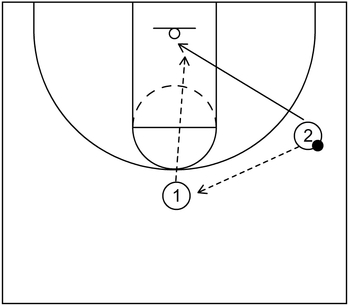
This is an example of basic pass and cut action when one player with the ball is near the wing and another player is at the top.
To begin, 1 receives the ball from 2 and then, 2 cuts to the basket after executing the pass. Next, 2 receives the ball again from 1 and scores near the rim.
Example 3
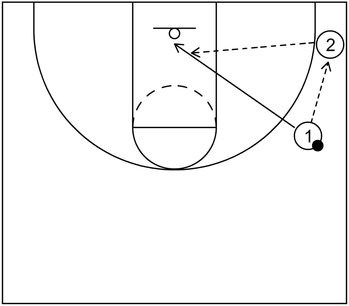
This is an example of basic pass and cut action when one player with the ball is on the wing and another player is in the corner.
To start, 2 receives the ball from 1 and afterwards, 1 cuts to the basket. From there, 1 receives the ball from 2 and scores in the lane.
Example 4
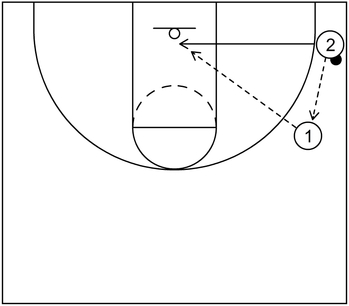
This is an example of basic pass and cut action when one player with the ball is in the corner and another player is near the wing.
To demonstrate, 1 receives the ball from 2 and after that happens, 2 cuts to the basket. Following that pass and cut action, 2 receives the ball from 1 and scores in the paint.
Example 5
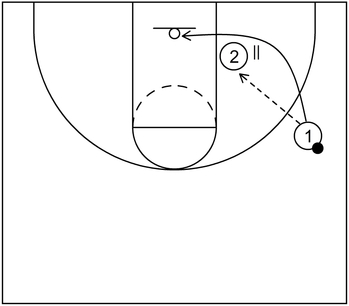
This is an example of basic pass and cut action when one player with the ball is near the wing and another player is near the low post block.
To begin, 2 receives the post entry pass from 1 and from there, 1 executes what is typically known as a Laker cut to the basket. From that point, 1 receives a handoff from 2 and could score at the rim with a layup or dunk.
What is an example of pass and cut action within the 5 out motion offense
Part 1
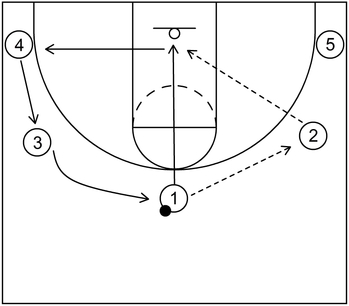
This is an example of pass and cut action within the 5 out motion offense. To start, 2 receives the ball from 1 and then, 1 cuts to the basket.
Also, as that occurs, 3 fills the vacant area at the top while 4 fills the left side wing. Next, 1 could receive the ball from 2 and score at the basket if that is open. If 1 is not open, then 1 could fill the vacant left side corner.
Part 2

Next, 5 could receive the ball from 2 and afterwards, 2 could cut to the basket. Also, as that cutting action happens, 3 could fill the empty right side wing while 4 fills the top, and 1 fills the left side wing.
From there, 2 could receive the ball from 5 if that is open. Otherwise, 2 could cut through to the open area near the left side corner.
Part 3
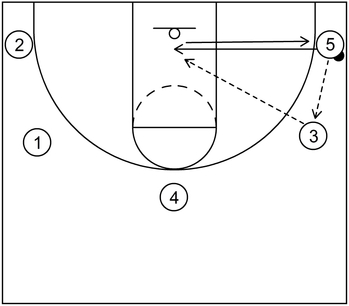
When 2 fills the left side corner, 3 can receive the ball from 5. After that pass occurs, 5 cuts to the basket and could receive the ball again from 3 if that is open. If 5 is not open, then 5 could simply execute a self replace cut near the right side corner.
Part 4
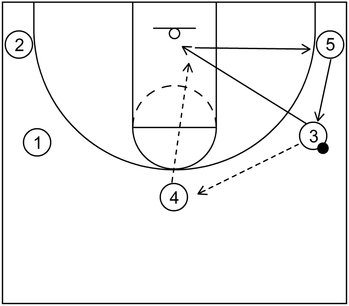
As soon as 5 fills the right side corner via self replace, 4 receives the ball at the top from 3. Next, 3 cuts to the basket and as that happens, 5 fills the right side wing.
If 3 is open while cutting, then 3 could receive the ball from 4. Otherwise, 3 could cut through to the vacant right side corner. Also, it is possible to execute the 5 out motion offense again.
To accomplish that, 1 would receive the ball from 4 and afterwards, 4 would cut to the basket. At that point, the continuity would keep going indefinitely or until the offensive team takes at least one field goal attempt.
What is an example of pass and cut action within a high post set play
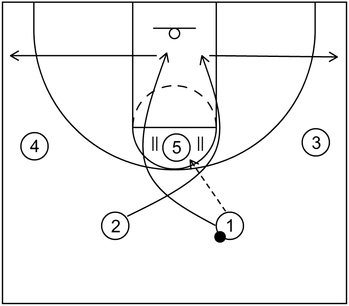
This is an example of pass and cut action within a high post set play and a type of basketball cut, typically known as a scissors cut. To begin, 5 is in the high post and receives the ball from 1.
Following that pass, 1 cuts to the basket near the left side high post elbow and could receive a handoff from 5 if that is open.
If 1 is not open, then 1 could cut through to the left side corner and as that occurs, 2 cuts to the basket near the right side high post.
As that second cut happens, 2 could receive the ball from 5 via handoff action and score near the basket. If 2 does not receive the ball, then 2 could cut through to the right side corner.
What is an example of pass and cut action within the Horns offense
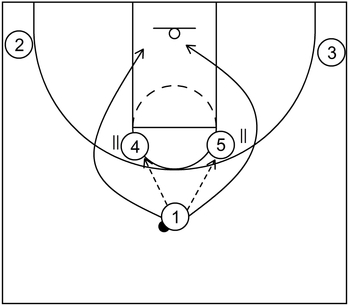
This is an example of simple pass and cut action within the Horns offense. To demonstrate, 4 or 5 could receive the ball from 1 near the high post elbows. Afterwards, 1 would follow that pass and receive the handoff from either 4 or 5.
From that point, 1 could score at the rim with a layup or alternatively, 1 could take a mid-range jump shot.
What is an example of pass and cut action within the triangle offense
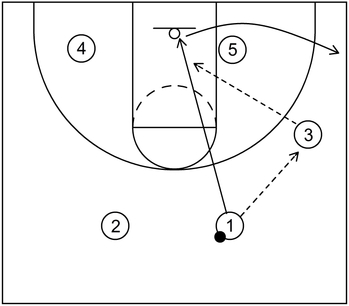
This is an example of basic pass and cut action within the triangle offense. To start, 3 receives the ball from 1 and immediately afterwards, 1 cuts to the basket.
From there, 1 could receive the ball from 3 and score at the rim with a layup or dunk. Otherwise, 1 could cut through to the right side corner to form the sideline triangle.
What is an example of pass and cut action within the UCLA offense

This is an example of pass and cut action within the UCLA offense. To begin, 3 receives the ball from 1 near the right side wing area.
After that, 1 cuts to the rim via the UCLA screen set by 5. Next, 1 could receive the ball from 3 and score at the basket.
Affiliate Disclosure: I may earn a commission on qualifying purchases made through the links below.
What are examples of pass and cut basketball drills
Drill 1
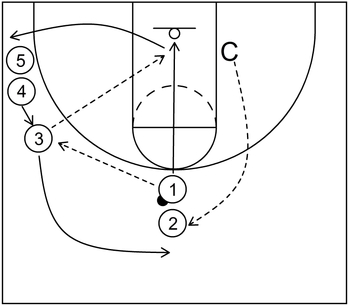
This is an example of a pass and cut drill that could be used as a warm up if necessary. The drill is set up with two lines near the top and the left side wing area. The players at the top will pass and cut to the basket.
Afterwards, the players on the wing will give the ball back to the cutting players and then those same cutting players will score at the rim with a layup or dunk.
From that point, the players near the wing will cut to the back of the line at the top while the players that scored will cut to the back of the line on the wing.
Moreover, there is a coach, denoted by the letter C that can get the ball out of the net and then pass it to a player without the ball at the top.
To demonstrate the drill, 3 receives the ball from 1 and then, 1 cuts to the basket. Next, 1 could receive the ball from 3 and score at the rim.
After that occurs, 3 cuts to the back of the line at the top while 1 cuts to the back of the line near the wing.
Also, 4 steps up to fill the vacant space where 3 was previously located while the coach gets the ball out of the net and passes it to player 2 at the top.
Drill 2

This is an example of a pass and cut drill derived from Individual & Team Skill Development Drills by Tara VanDerveer which can help the players work on passing, cutting, and scoring at the rim.
The drill is set up with three lines; one near the right side corner, one near the right sideline, and another one near the left slot area. Additionally, there is also a single player near the basket.
In terms of instructions for the drill, the players in the right corner will pass to a teammate near the sideline and then immediately receive the ball again from that same teammate. After that, the players in the corner will then throw a diagonal pass across to the players near the left slot.
Furthermore, the players in the corner that executed the diagonal pass will then follow it and cut to the back of the line near the left slot. Also, as that diagonal pass occurs, the players near the sideline will then cut to the basket.
Next, the players in the left slot will then pass to the cutting players and from that point, those same cutting players will score via a layup or dunk at the rim. It is also important to note that the cutting players should not dribble the ball upon receiving it.
Moreover, after a player in the left slot executes a pass to a cutter, that same left slot player should cut to the back near the sideline.
Following the layup or dunk, the player that was already near the basket will get the ball out of the net and pass it to a teammate that is not already holding a basketball in the right corner.
In addition to that, the player that was initially near the basket will follow their own pass and cut to the back of the line near the right corner. The drill can keep going for a certain length of time or until each player progresses through each line.
To demonstrate the drill, 3 receives the ball from 1 and immediately passes it back. After that, 5 receives the ball from 1 and as that diagonal pass occurs, 1 follows it to the back of the left slot line.
Also, at the same time, 3 cuts to the basket and receives the ball from 5. Next, 3 scores with a layup or dunk at the rim and as that happens, 5 cuts to the back near the right sideline.
From that point, 7 gets the ball out of the net after the layup or dunk and then, 2 receives the ball from 7. Furthermore, 7 follows that pass to the back of the line near the right corner.
Additionally, after scoring at the basket, 3 should stay near the basket and get the ball out of the net for the next cutter.